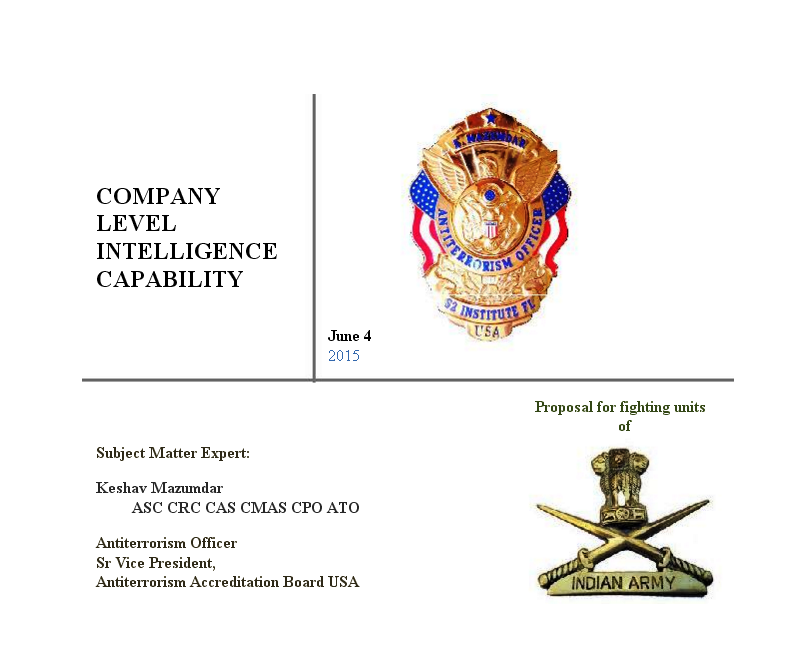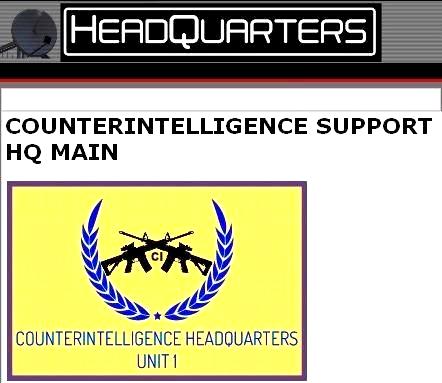

COUNTERINTELLIGENCE
ACTION PLAN
TO DETERMINE THREAT DOCTRINE. ( ASYMMETRIC ADVERSARY/HYBRID ENEMY)
TO DETERMINE THREAT INTENT FROM THREAT DOCTRINE
THE NEED TO KNOW ENEMY DOCTRINE.
We must have all historical and current information about the threat stored in a database. The database should have doctrinal templates about the threat. For example we have conducted a HUMINT/SIGINT study about the threat recently. We can now overlay the HUMINT situation over the extracted threat doctrinal template from the database and compare to find any similarities between current and doctrinal activities, tactics, methods of collection (CI),deployments etc. In this manner we compare against as many adversary doctrinal templates we can extract from the database and select that one that bears close resemblance to the current HUMINT overlay. That is to say that resembles the current situation as assessed by HUMINT/SIGINT Assets.Thus we can guage with a high level of confidence the future intent of the enemy going by his doctrinal practices.
Hence its very important to know threat doctrine. Even the irregular asymmetric unconventional enemy has an unwritten doctrine which should be compiled and stored by our intelligence analysts. What we can do is conduct a thorough study of past and current threat tactics,techniques,distinctive signatures like preferred methods of intelligence collection , methods of attack, weapons/explosives used. There is more than this to collect and store in the database. Remember open source intelligence accounts for more than 90% of all intelligence collected about the adversary. So thoroughly glean open source and extract as much information as possible about the threat. For example from the internet , media , etc we can get information about threat activities in other areas/states/nations which can be documented , analyzed to extract threat intelligence collection methods , tactics and techniques of attack , targeting methods , dry runs, weapons used , explosives used, population centric center of gravity locations, how they operate in an urban-semi-0urban battlespace,how they operate in a jungle environment, who are their abettors from among the local criminal enterprises , how they communicate and the extent of communication systems/mobiles/couriers usage and the preferred method of communication so as not to be easily intercepted , threat deception tactics and threat maneuver tactics and so on—in short the battle field operating system specific to an unconventional asymmetric threat and tactics , techniques and procedures together with C2 and combat service support (here it will be from abetting nations, criminal enterprises and even the local population).Whether or not a doctrine exists or is accessible , we must attempt fully to put down their doctrine on paper , properly format it and document it and then store it in a database and what with the scores of patterns analyzing/other extraction software easily available from the internet including link diagramming/association matrix or time event charting , we can extract all doctrinally preferred tactics , techniques and procedures from the database thus getting to know the enemy much more better in advance. We can extract different doctrinal templates and stack them in the database for immediate comparison with our HUMINT situation overlays when required , instantly without wasting time by simply querying the database with proper query syntax.
Remember even the most elusive , cunning threat group will always have a history of activities which he can’t erase as its embedded in the time, we only have to get the maximum possible information about him to make a satisfactory assessment of his war doctrine. Yes we must be prepared to adjust our doctrine to his doctrine, if we stick to our conventional doctrinal methods then surely we cannot expect to gain information superiority and that competitive edge. We must ADAPT to the enemy’s doctrine.
Determine threat intent:
Questions the CI operative should ask himself:
Which area will the adversary target?
Why has he selected that particular area?
Has there been past instances of targeting that area?
Are there any particular / distinctive threat signatures?
Any estimate when the targeting can take place?
How will the adversary collect intelligence about the target area?
Are there any particular instances of adversary collection attempts on the target area in the past? Have they been documented?
Does the adversary have a doctrine which can be accessed and if so does the doctrine suggest possible threat actions?

Keshav Mazumdar
Director
Combat Forces Education & Training
